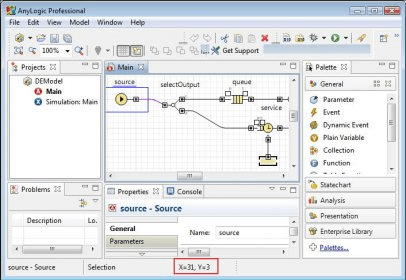

Your two quoted bits of text don't contradict each other. I'd reiterate though that any optimisation involving 255+ parameters is probably pointless, with little likelihood of finding a near-optimum (and if you have a model with that many parameters - given that you might genuinely want to vary all of them independently - you have a model design problem).
Anylogic price code#
(But this is simple boilerplate code you can copy and reuse once you've 'learnt' it.) But this requires writing some specific Java to allow you to import external data from a dynamically-defined filename into the AnyLogic DB, or the equivalent but reading directly from the Excel file. 'Parameters' may be varied in related sets, so this can boil down to a single parameter which provides, say, the filename to load the relevant external data from (and you vary that across a pre-prepared set). But oftenĪ load of 'parameters' will stay fixed so those can be supplied from this external data.

The issue here is that AnyLogic's multi-run experiments (including optimisation-based ones) expect to be varying top-level agent parameters. Use external data (e.g., Excel loaded into the AnyLogic DB) to provide some/all of the 'parameters' for your model.

The Custom Experiment help page has examples of this. For optimisation, you'd also have to use a Custom Experiment to define an optimisation where, for example, you might have 500 optimisation variables but your code to setup the model from them sets up your 3 model parameter class instances with those 500 values.
Anylogic price how to#
(Just look at any Java tutorials for how to define simple classes which are effectively just data structures.) But now your experiments have to create appropriate instances of those classes as parameter values (and this makes things like a Parameter Variation experiment harder to define you'd typically use a Custom Experiment instead since then you have full control of how you setup the parameters for each run). Structure your parameters in 'raw' Java classes so, for example, your Main agent may have 3 parameters of type CoreParameters, ClimateVariables and EconomicVariables. There are several ways to avoid the limit: I'm still trying to distinguish between what can be asked and what not. Sorry if this question is not under the scope of SOF. I'm I missing a Java trick here? would it be possible in any way to perform an optimization experiment in AnyLogic with more than 255 parameters? Therefore, it seems that using Java Class would not help. With several built-in functionalities, ( ) The best option would be to follow Java best practices and have a JavaĬlass (which has almost no limitations) ( Maximum number of parameters in a Agent-Type)ĪnyLogic provides Agents, that are basically predefined classes The question is about ways to overcome this limitation. The question here is not why 255 parameters are required for an optimization problem or if simulation-based optimization is the best way to handle a problem with more than 255 parameters (Decision Variables). The number of method parameters is limited to 255 ( ) The top-level agent can not have more than 255 parameters. You may vary only the parameters of the top-level agent.


 0 kommentar(er)
0 kommentar(er)
